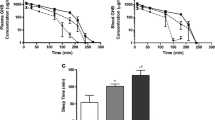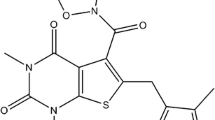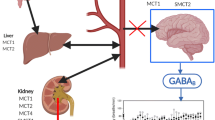Abstract
An overdose of γ-hydroxybutyric acid (GHB), a drug of abuse, results in fatality caused by severe respiratory depression. In this study, a semi-mechanistic pharmacokinetic/pharmacodynamic (PK/PD) model was developed to characterize monocarboxylate transporter 1 (MCT1)-mediated transport of GHB, as well as effects of GHB on respiration frequency, for IV doses of 200, 600, and 1500 mg/kg in rats. The proposed PK/PD model for GHB consists of nonlinear metabolism of GHB in the liver, MCT1-mediated renal reabsorption with physiologically relevant concurrent fluid reabsorption, MCT1-mediated uptake into the brain, and direct effects of binding of GHB to GABAB receptors on the PD parameter, respiration frequency. Michaelis-Menten affinity constants for metabolism, renal reabsorption, and uptake into and efflux from the brain were fixed to the observed in vitro values. The IC 50 value for the effect of GHB on respiration frequency was fixed to a reported value for binding of GHB to GABAB receptors. All physiological parameters were fixed to the reported values for a 300-g rat. The model successfully captured the GHB PK/PD data and was further validated using the data for a 600-mg/kg dose of GHB after IV bolus administration. Unbound GHB brain ECF/blood partition coefficient (Kp u,u ) values obtained from the model agreed well with values calculated using experimental ECF concentrations obtained with brain microdialysis, demonstrating the physiological relevance of this model. Sensitivity analysis indicated that the PK/PD model was stable. In conclusion, we developed a semi-mechanistic and physiologically relevant PK/PD model of GHB using in vitro drug-transporter kinetics and in vivo PK/PD data in rats.





Similar content being viewed by others
References
Maitre M. The gamma-hydroxybutyrate signalling system in brain: organization and functional implications. Prog Neurobiol. 1997;51(3):337–61.
Mamelak M, Scharf MB, Woods M. Treatment of narcolepsy with gamma-hydroxybutyrate. A review of clinical and sleep laboratory findings. Sleep. 1986;9(1 Pt 2):285–9.
Gallimberti L, Spella MR, Soncini CA, Gessa GL. Gamma-hydroxybutyric acid in the treatment of alcohol and heroin dependence. Alcohol. 2000;20(3):257–62.
Wong CG, Gibson KM, Snead OC 3rd. From the street to the brain: neurobiology of the recreational drug gamma-hydroxybutyric acid. Trends Pharmacol Sci. 2004;25(1):29–34.
Schwartz RH, Milteer R, LeBeau MA. Drug-facilitated sexual assault ('date rape'). South Med J. 2000;93(6):558–61.
Okun MS, Boothby LA, Bartfield RB, Doering PL. GHB: an important pharmacologic and clinical update. J Pharm Pharm Sci. 2001;4(2):167–75.
Galicia M, Nogue S, Miro O. Liquid ecstasy intoxication: clinical features of 505 consecutive emergency department patients. Emerg Med J. 2011;28(6):462–6.
Zvosec DL, Smith SW, Porrata T, Strobl AQ, Dyer JE. Case series of 226 gamma-hydroxybutyrate-associated deaths: lethal toxicity and trauma. Am J Emerg Med. 2011;29(3):319–32.
Mason PE, Kerns WP 2nd. Gamma hydroxybutyric acid (GHB) intoxication. Acad Emerg Med. 2002;9(7):730–9.
Lettieri JT, Fung HL. Dose-dependent pharmacokinetics and hypnotic effects of sodium gamma-hydroxybutyrate in the rat. J Pharmacol Exp Ther. 1979;208(1):7–11.
Palatini P, Tedeschi L, Frison G, Padrini R, Zordan R, Orlando R, et al. Dose-dependent absorption and elimination of gamma-hydroxybutyric acid in healthy volunteers. Eur J Clin Pharmacol. 1993;45(4):353–6.
Scharf MB, Lai AA, Branigan B, Stover R, Berkowitz DB. Pharmacokinetics of gammahydroxybutyrate (GHB) in narcoleptic patients. Sleep. 1998;21(5):507–14.
Arena C, Fung HL. Absorption of sodium gamma-hydroxybutyrate and its prodrug gamma-butyrolactone: relationship between in vitro transport and in vivo absorption. J Pharm Sci. 1980;69(3):356–8.
Morris ME, Hu K, Wang Q. Renal clearance of gamma-hydroxybutyric acid in rats: increasing renal elimination as a detoxification strategy. J Pharmacol Exp Ther. 2005;313(3):1194–202.
Sporer KA, Chin RL, Dyer JE, Lamb R. Gamma-hydroxybutyrate serum levels and clinical syndrome after severe overdose. Ann Emerg Med. 2003;42(1):3–8.
Cui D, Morris ME. The drug of abuse gamma-hydroxybutyrate is a substrate for sodium-coupled monocarboxylate transporter (SMCT) 1 (SLC5A8): characterization of SMCT-mediated uptake and inhibition. Drug Metab Dispos. 2009;37(7):1404–10.
Wang Q, Darling IM, Morris ME. Transport of gamma-hydroxybutyrate in rat kidney membrane vesicles: role of monocarboxylate transporters. J Pharmacol Exp Ther. 2006;318(2):751–61.
Wang Q, Lu Y, Morris ME. Monocarboxylate transporter (MCT) mediates the transport of gamma-hydroxybutyrate in human kidney HK-2 cells. Pharm Res. 2007;24(6):1067–78.
Wang Q, Lu Y, Yuan M, Darling IM, Repasky EA, Morris ME. Characterization of monocarboxylate transport in human kidney HK-2 cells. Mol Pharm. 2006;3(6):675–85.
Wang Q, Morris ME. The role of monocarboxylate transporter 2 and 4 in the transport of gamma-hydroxybutyric acid in mammalian cells. Drug Metab Dispos. 2007;35(8):1393–9.
Morris ME, Felmlee MA. Overview of the proton-coupled MCT (SLC16A) family of transporters: characterization, function and role in the transport of the drug of abuse gamma-hydroxybutyric acid. AAPS J. 2008;10(2):311–21.
Roiko SA, Felmlee MA, Morris ME. Brain uptake of the drug of abuse gamma-hydroxybutyric acid in rats. Drug Metab Dispos. 2012;40(1):212–8.
Dave RA, Morris ME. Semi-mechanistic kidney model incorporating physiologically-relevant fluid reabsorption and transporter-mediated renal reabsorption: pharmacokinetics of gamma-hydroxybutyric acid and L-lactate in rats. J Pharmacokinet Pharmacodyn. 2015;42(5):497–513.
Meno-Tetang GM, Li H, Mis S, Pyszczynski N, Heining P, Lowe P, et al. Physiologically based pharmacokinetic modeling of FTY720 (2-amino-2[2-(-4-octylphenyl)ethyl]propane-1,3-diol hydrochloride) in rats after oral and intravenous doses. Drug Metab Dispos. 2006;34(9):1480–7.
Peters SA. Appendices. Physiologically-based pharmacokinetic (PBPK) modeling and simulations: principles, methods, and applications in the pharmaceutical industry. Wiley; 2012. p. 407.
Morse BL, Vijay N, Morris ME. Mechanistic modeling of monocarboxylate transporter-mediated toxicokinetic/toxicodynamic interactions between gamma-hydroxybutyrate and L-lactate. AAPS J. 2014;16(4):756–70.
Niederalt C, Wendl T, Kuepfer L, Claassen K, Loosen R, Willmann S, et al. Development of a physiologically based computational kidney model to describe the renal excretion of hydrophilic agents in rats. Front Physiol. 2012;3:494.
Jobin J, Bonjour JP. Measurement of glomerular filtration rate in conscious unrestrained rats with inulin infused by implanted osmotic pumps. Am J Phys. 1985;248(5 Pt 2):F734–8.
Khurana I. Excretory system. Textbook of human physiology for dental students, second edition: Elsevier Health Sciences APAC; 2014. p. 280–1.
Lash LH. Principles and methods of renal toxicology. In: Hayes AW, editor. Principles and methods of toxicology. Fifth Edition: Taylor & Francis; 2007. p. 1513–4.
Lote CJ. Summary of the principal reabsorptive and secretory processes. Principles of renal physiology, fourth edition. New York: Springer Science & Business Media; 2000. p. 161–2.
Wang X, Wang Q, Morris ME. Pharmacokinetic interaction between the flavonoid luteolin and gamma-hydroxybutyrate in rats: potential involvement of monocarboxylate transporters. AAPS J. 2008;10(1):47–55.
Morse BL, Felmlee MA, Morris ME. Gamma-hydroxybutyrate blood/plasma partitioning: effect of physiologic pH on transport by monocarboxylate transporters. Drug Metab Dispos. 2012;40(1):64–9.
Ishige K, Aizawa M, Ito Y, Fukuda H. Gamma-butyrolactone-induced absence-like seizures increase nuclear CRE- and AP-1 DNA-binding activities in mouse brain. Neuropharmacology. 1996;35(1):45–55.
Morse BL, Morris ME. Effects of monocarboxylate transporter inhibition on the oral toxicokinetics/toxicodynamics of gamma-hydroxybutyrate and gamma-butyrolactone. J Pharmacol Exp Ther. 2013;345(1):102–10.
Vijay N, Morse BL, Morris ME. A novel monocarboxylate transporter inhibitor as a potential treatment strategy for gamma-hydroxybutyric acid overdose. Pharm Res. 2015;32(6):1894–906.
Vijay N, Morris ME. Role of monocarboxylate transporters in drug delivery to the brain. Curr Pharm Des. 2014;20(10):1487–98.
Woodhall PB, Tisher CC. Response of the distal tubule and cortical collecting duct to vasopressin in the rat. J Clin Invest. 1973;52(12):3095–108.
Felmlee MA, Roiko SA, Morse BL, Morris ME. Concentration-effect relationships for the drug of abuse gamma-hydroxybutyric acid. J Pharmacol Exp Ther. 2010;333(3):764–71.
Felmlee MA, Wang Q, Cui D, Roiko SA, Morris ME. Mechanistic toxicokinetic model for gamma-hydroxybutyric acid: inhibition of active renal reabsorption as a potential therapeutic strategy. AAPS J. 2010;12(3):407–16.
D’Argenio DZ, Schumitzky A. and Wang X. ADAPT 5 user’s guide: pharmacokinetic/pharmacodynamic systems analysis software, fourth edition. Biomedical Simulations Resource, Los Angeles, CA 2009.
Lyon RC, Johnston SM, Panopoulos A, Alzeer S, McGarvie G, Ellis EM. Enzymes involved in the metabolism of gamma-hydroxybutyrate in SH-SY5Y cells: identification of an iron-dependent alcohol dehydrogenase ADHFe1. Chem Biol Interact. 2009;178(1–3):283–7.
Zhang Y, Huo M, Zhou J, Xie S. PKSolver: an add-in program for pharmacokinetic and pharmacodynamic data analysis in Microsoft Excel. Comput Methods Prog Biomed. 2010;99(3):306–14.
Raybon JJ, Boje KM. Pharmacokinetics and pharmacodynamics of gamma-hydroxybutyric acid during tolerance in rats: effects on extracellular dopamine. J Pharmacol Exp Ther. 2007;320(3):1252–60.
Felmlee MA, Krzyzanski W, Morse BL, Morris ME. Use of a local sensitivity analysis to inform study design based on a mechanistic toxicokinetic model for gamma-hydroxybutyric acid. AAPS J. 2011;13(2):240–54.
ACKNOWLEDGEMENTS
This work was supported by the National Institutes of Health National Institute on Drug Abuse [grant R01DA023223]. We would like to acknowledge Dr. Bridget Morse, Dr. Nisha Vijay, and Robert Jones for their contributions.
Author information
Authors and Affiliations
Corresponding author
Electronic Supplementary Material
ESM 1
(DOCX 3207 kb)
Rights and permissions
About this article
Cite this article
Dave, R.A., Follman, K.E. & Morris, M.E. γ-Hydroxybutyric Acid (GHB) Pharmacokinetics and Pharmacodynamics: Semi-Mechanistic and Physiologically Relevant PK/PD Model. AAPS J 19, 1449–1460 (2017). https://doi.org/10.1208/s12248-017-0111-7
Received:
Accepted:
Published:
Issue Date:
DOI: https://doi.org/10.1208/s12248-017-0111-7




